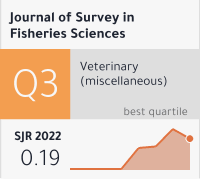Feeding preference of juvenile mud crab (Scylla olivacea, Herbst, 1896) in captivity
DOI:
https://doi.org/10.17762/sfs.v7i2.132Keywords:
Mud crab, Crustacea, Aquaculture, Feeding behaviourAbstract
Mud crab (Scylla olivacea, Herbst 1896) is a valuable organism which is highly priced in the seafood industry. In Malaysia, the aquaculture industry of mud crabs is still in its infancy stage. In order to develop a feeding strategy for the aquaculture of mud crabs, their feeding preference and behaviour should be well understood. This study was conducted to identify if there is any preference to food for juvenile mud crabs kept in captivity within laboratory conditions. Prior to behavioural observations, crabs were starved for 5 days. Crabs were observed for a duration of 30 minutes and tested with natural food (fish muscle and chicken intestine), pelleted feed (fish meal pellets, PF; poultry offal meal pellets, PP) and agar-based feed (fish meal agar, AF; poultry offal meal agar, AP). The experiment was conducted by observation for a period of 30 minutes and time taken to approach and consume each given feed was recorded. The frequency of the type of food chosen was expressed as attraction to feed score index. When presented with two types of natural diets, the mud crabs had a significant inclination towards the chicken intestines displaying higher attraction to feed score index. Whilst given the choice between fish meal-based pellets (PF) and poultry offal meal-based pellets (PP), no significant difference was displayed in the time taken to approach and consume the feed, but significantly higher attraction to feed scores for PP. Chicken intestine was presented with the four types of formulated feed respectively, but revealed no significant differences in attraction to feed score index. Fish meal-based agar diets (AF) showed significant attraction to feed index score and faster approach time compared to PP. Overall results revealed that juvenile mud crabs accepted all types of tested feed, and showed significant preference towards AF when compared to PP. The findings indicate potential for the utilization of agar based diets for aquaculture of mud crabs.










